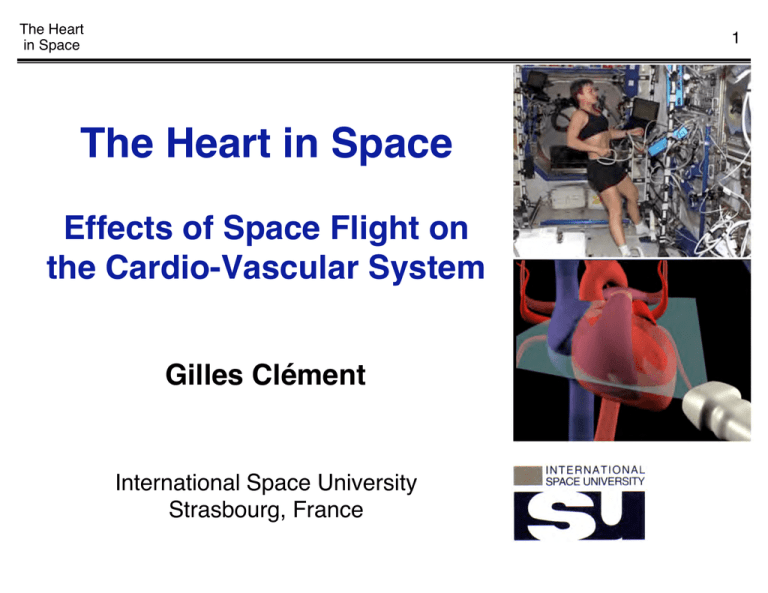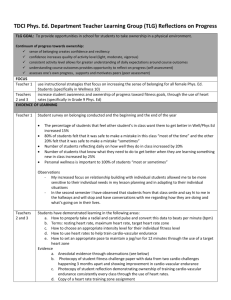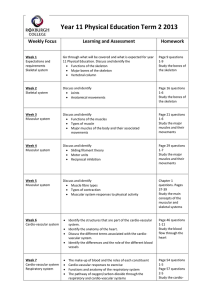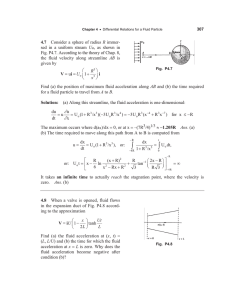The Heart in Space Effects of Space Flight on the Cardio-Vascular System
advertisement

The Heart in Space 1 The Heart in Space Effects of Space Flight on the Cardio-Vascular System Gilles Clément International Space University Strasbourg, France The Heart in Space Lecture Outline • How the cardio-vascular system works in Earth gravity to ensure constant blood pressure and to regulate blood flow to the body tissues • The effects of space flight on the cardio-vascular system: – Before and during launch – On-orbit – fluid shift, heart rhythm disturbances, decrease in maximal exercise capacity – Post-flight – orthostatic intolerance, i.e., syncope during stand test • Implications of such changes for long-term missions, and potential countermeasures 2 The Heart in Space The Problem 3 • U.S. space program – Mercury-8 (9 hrs): modest increase in – – – – heart rate postflight Mercury-9 (34 hrs): increase in heart rate (132 supine; 188 standing) postflight Gemini: fainting episode Apollo: heart rhythm disturbances Shuttle: 8 episodes of dizziness or fainting in the first 26 missions • Soviet/Russian space program – Soyuz-9 crew was so severely incapacitated they could not egress the capsule without assistance – Long-duration spaceflights: many returning crews are incapacitated and are unable to egress the capsule without help Photo NASA The Heart in Space So why is this a big deal? • Pilots fly upside down at minus 1G instead of 0G with no problem • How can these space travelers perform nominally on orbit and then be so incapacitated when they land? • We see this on Earth with patients who have certain types of cardio-vascular disease • Did we select individuals who were susceptible to these problems? • Can a incapacitated crew respond to an emergency upon launch or landing? 4 The Heart in Space Cardio-Vascular Risk • Based on experience with analog Earth data (submarines, Antarctic bases, remote outposts, etc.) the risk of a serious cardio-vascular event (heart attack, rhythm disturbance, etc.) happening on the ISS is at least once in 20 years • The risk of cardio-vascular medical events happening during or after a mission can be divided into two categories: – Medical events which occur as a consequence of the expected cardio-vascular physiological changes induced by spaceflight – Medical events which occur as a consequence of pre-existing cardio-vascular disease which are aggravated by spaceflight 5 The Heart in Space NASA Astronaut Selection • The initial cardio-vascular exam for astronaut selection is similar to the non-pilot U.S. Air Force physical exam • This initial medical exam is then followed by the NASA astronaut selection physical, which is similar to U.S. Air Force fighter pilot physical exam • As a rule, astronaut candidates are in excellent physical shape and many have increased heart muscle mass compared to terrestrial “norms” 6 The Heart in Space Cardio-Vascular Physiology As organisms increased in size (number of cells), isolated individual cells required to ingest nutrients (food and oxygen—O2) and excrete waste (byproducts and carbon dioxide—CO2) 7 The Heart in Space Cardio-Vascular Physiology 8 • The heart pumps blood through blood vessels to deliver oxygen and pick up CO2 from various organs • Contraction of leg muscles Lujan and White (1995) helps to pump blood toward the heart (venous return) The Heart in Space Definitions • Heart rate is how fast the heart is beating (pulse) • On Earth, there is a large pressure gradient from the head to the feet, with the mean arterial blood pressure being about 70 mmHg at the head level, 100 mmHg at the heart level, and 200 mmHg at the feet level • Flow through a blood vessel is determined by 2 factors: – The force that pushes the blood through the vessel – The resistance of the vessel to the blood flow • Blood flow in the entire human circulation is about 5000 ml/min at rest, but may be 5-6 times greater during exercise. The amount of blood pumped by the heart in one minute is called the cardiac output 9 The Heart in Space Cardiac Output 10 • Stroke volume is the volume of blood discharged from the heart left ventricle with each contraction (about 70 ml at rest) • Cardiac Output (ml of blood/min) = Stroke Volume x Heart Rate (ml of blood/beat) (beats/min) Lujan and White (1995) • Some factors that influence arterial blood pressure : The Heart in Space Regulation of Blood Pressure • The rapid transition between lying own, sitting, and upright postures requires that the heart and blood vessels adjust very quickly • The baroreceptor reflex is the body's rapid response system for dealing with changes in blood pressure • Baroreceptors are located in the neck arteria (carotid) and in the aorta • A decrease in pressure (distention) will cause the cardio-vascular system to compensate by increasing cardiac output (stroke volume and/or heart rate) • Spaceflight deconditions baroreceptor response, resulting in larger changes in baroreceptor distention needed to induce the same changes in heart rate compared to 1-g 11 The Heart in Space Assessment of Baroreflex 12 • The baroreflex sensors can be “fooled” by manipulating the pressure outside the neck using an inflatable cuff • Increasing the cuff pressure will reduce the distension of the baroreceptors, the equivalent of a decrease in arterial pressure • This will cause the cardiovascular system to compensate by increasing cardiac output (stroke volume and/or heart rate) Photo NASA • Applying vacuum to the neck cuff will increase baroreceptors distension, simulating an increase in arterial pressure, resulting in a decrease in cardiac output The Heart in Space Pre-Launch Position 13 1-2 hours prior to expected launch • Crew can be in the Shuttle for as long as 4 hours before Mission Control considers a launch scrub • Supine position with 90° hip and knee flexion in order to limit launch acceleration to the +Gx direction • The effect is that significant blood volume is placed above the heart, increasing load to the heart, central venous pressure, cardiac volumes, and cardiac output • The body compensates for this by reducing blood volume through urination and reduced thirst • The astronauts sometimes prefer to restrict their fluid intake prior to launch and “fly dry” • Reduction in blood volume on the launch pad may impair the ability to emergency egress (syncope upon standing) +Gx Lujan and White (1995) • The crew is placed in the Shuttle approximately The Heart in Space Three Phases of Space Flight • The transition between upright, sitting, and lying down postures requires that the heart and blood vessels adjust very quickly Pre-flight • However, the control centers are not stimulated in microgravity • These deconditioned control centers do not respond appropriately to orthostatic challenge after space flight In-flight Post-flight 14 The Heart in Space Pre-Launch Issues • Could every crewmember use the escape system, and egress rapidly the launch site without any assistance wearing a 50 kg spacesuit ? Photos NASA 15 The Heart in Space On-Orbit — Fluid Shift a. On Earth, gravity exerts a downward force to keep fluids flowing to the lower body (A) b. In space, the fluids tend to redistribute toward the chest and upper body (B). This is responsible for the face congestion. At this point, the body detects a “flood” in and around the heart c. The body rids itself of this perceived “excess” fluid. The body functions with less fluid and the heart becomes smaller (C) d. Upon return to Earth, gravity again pulls the fluid downward, but there is not enough fluid to function normally on Earth (D) 16 The Heart in Space On Orbit — Fluid Shift 17 vascular and tissue spaces is about 1-2 liters (about a 10% volume change compared to preflight) Lujan and White (1995) • Total loss of fluid from the The Heart in Space On Orbit — Fluid Shift • Microgravity removes the hydrostatic gradient in the venous vascular system • 1-2 liters of fluid shift toward the head • Crewmembers sense this fluid shift and describe it as “fullness in the head” or a nasal stuffiness similar to a chronic sinus congestion 18 The Heart in Space Ultrasound Imaging 19 The Heart in Space On Orbit — Cardiac Output • Ultrasound imaging revealed that heart volume first increases, probably because of the increased volume of blood flowing into the heart • Then the heart volume slowly decreases, ending up smaller compared with its size on Earth, presumably because: – The excess blood and fluid have been eliminated – The heart does not have to pump the blood against gravity – Leg muscles are less used • Maximal exercise capability (VO2 max) in orbit is not different from preflight, but is reduced immediately post-flight • Fit subjects demonstrated larger (16%) reduction in VO2 max and plasma volume than unfit subjects (only 6% reduction) 20 The Heart in Space On Orbit — EVA • During Extra-Vehicular Activity (EVA) astronauts may be working hard for 6 hours in a space suit with mean metabolic rates of 800 kcal/hour and 5-10 minute peaks of over 1500 kcal/hour • Russian cosmonauts lose 0.7-2.2 kg (mostly fluids) during a typical EVA • The acute dehydration caused by EVA may aggravate an already deconditioned state caused by exposure to microgravity Photo NASA 21 The Heart in Space On Orbit — Heart Rhythm • Serious heart rhythm disturbances were noted during the Apollo program, both during EVA on the Moon and after return to Earth • Both astronauts were given excessive work loads on the Moon, and one had a significant cardiac event 2 years after the mission • One Mir crewmember showed a sustained 14-beat run of ventricular tachycardia after one month in orbit 22 The Heart in Space Re-Entry — Effects of G Forces • Re-entry forces exerted along Gx axis in capsules – no need for the astronaut to “fly” the vehicle • Gz forces in Shuttle. However, 1.5 Gz during re-entry after 16 days of cardio-vascular deconditioning in microgravity may be as provocative as 5-6 Gz in a fighter aircraft • Loss of consciousness (syncope) may result from a decrease in blood flow to the brain (cerebral hypoperfusion) 23 The Heart in Space Tolerance to Acceleration • Tolerance to prolonged acceleration depends on : – Magnitude – Duration – Direction of force – Restraints – Protective systems • Individual tolerance depends on : – Age – Training – Underlying physical condition • Space flight has been demonstrated to reduce tolerance to sustained +Gz acceleration (Shuttle) and +Gx acceleration (Soyuz) 24 The Heart in Space Tolerance to Acceleration (Cont'd) Vertical Accelerations (Gz, up is positive) 16 12 - 14 11.4 4.5 - 6.3 3.9 - 5.5 3.4 - 4.8 4.5 -1 -2 -5 Event or Symptom limit of sustained human tolerance, centrifuge ejection seat aerobatic airplane, 2002 loss of consciousness complete loss of vision (blackout) partial loss of vision (grayout) rollercoaster, maximum at bottom of first dip congestion of blood in head throbbing headache, reddening of vision (redout) limit of sustained human tolerance, centrifuge Horizontal Accelerations (Gx, magnitude only) 0.4 0.8 2 Event or Symptom “pedal to the metal” in a typical car “pedal to the metal” in a high performance sports car Extreme Launch™ rollercoaster at start 3 Space Shuttle at takeoff; jet fighter landing on aircraft carrier 8 31 - 25 40 limit of sustained human tolerance, centrifuge tolerance to centrifuge, 5 s duration USAF chimpanzee, centrifuge, 60 s duration 60 chest acceleration during car crash at 48 km/h with airbag 70 - 100 crash that killed Diana, Princess of Wales, 1997 247 3400 USAF chimpanzee, rocket powered impact sled, 0.001 s impact acceleration limit for crash-survivable flight recorder 25 The Heart in Space Impact Acceleration • Tolerance to impact acceleration depends on : – Peak acceleration – Pulse shape – Magnitude, direction, and duration of impact acceleration – Characteristics of human subject – Subject's restraint system – Acceleration history prior to event • As with entry acceleration, illness or injury are expected to be additive with space flight deconditioning in d ecreasing impact tolerance • Impact attenuation – crew couch 26 The Heart in Space Landing – Orthostatic Intolerance • 'Ortho' = upright; 'Static' = standing • 'Intolerance' = Feeling of lightheadedness or fainting associated with upright posture at 1 g • Tested by completing a 10-minute stand test – failure when patient is forced to sit down to prevent syncope • Increased risk to crewmembers during entry, landing, and egress • Affects about 20% of the astronaut population after short-duration (Shuttle) space flight • Affects about 85% of crewmembers after long-duration (Mir and ISS) space flight 27 The Heart in Space Landing – Shuttle • Both heart rate & blood pressure increase during re-entry • Syncope is caused by a diminished blood flow to the brain when going from sitting to standing • Possible mechanisms – low baroreceptor responsiveness, relaxation of blood vessels, loss of fluids, CNS adaptation 28 The Heart in Space Landing – Decreased Exercise Capacity • Large decline over first 30-90 days on ISS • Subsequent improvement may be due to countermeasures • Early in-flight loss (even with countermeasures) may be related to altered CV control mechanisms/body fluid volumes, and operations • Aerobic capacity declines again after landing and appears restored by R+30 days in ISS crew 5 % Change 0 -5 -10 -15 -20 PRE FD30 FD60 FD90 FD120 FD150 FD180 R+5 R+30 29 The Heart in Space Countermeasures — In-flight Periodic monitoring to detect manifestation of previously asymptomatic cardiovascular disease 30 The Heart in Space Countermeasures — In-flight In-flight exercise and Low Body Negative Pressure (LBNP) have a protective effect on the increase in heart rate and fall in blood pressure during standing after flight LBNP (“Chibis”) Photos NASA and RSA Loading suit (“Penguin”) Thigh cuffs (“Brazlet”) 31 The Heart in Space • • • • Countermeasures —Landing Fluid and salt loading Anti-G garment Liquid cooling garment Recumbent seating during re-entry for flights > 30 days Photos NASA 32 The Heart in Space Countermeasures — Spin-Offs 33 The Heart in Space Ground-Based Simulation 34 Photos ESA-MEDES Bed Rest Studies (6° head-down tilt) The Heart in Space Bed Rest Model • Bed rest with -6 deg head down simulates the effects of microgravity on cardio-vascular response • Within the first week, noticeable atrophy of muscle tissue • After two weeks, bone density declines as significant amounts of calcium are lost in the urine • Exercise regimens and LBNP are evaluated to determine which is more effective at preventing: – Cardiovascular deconditioning – Orthostatic intolerance – Fluid shift – Muscle atrophy 35 The Heart in Space Tilt Test After Bed Rest Documents MEDES • After 15-90 days of bed rest, orthostatic intolerance is evaluated by suddenly tilting the subject from the supine to the upright position • Heart rate increases and blood pressure decreases, causing loss of consciousness (syncope) • This orthostatic intolerance is similar to that observed in the astronauts when they stand up immediately after spaceflight 36 Heart rate Blood pressure The Heart in Space Cardio-Vascular Research • Mechanistic studies – Structured to control for many parameters and develop a model of the effects of space flight on cardio-vascular responses (e.g., neck cuff during a bed rest study) • Descriptive studies – Cardio-vascular anomalies in one crewmember, which may have operational implications – Studies (prospective and retrospective) on a large number of astronauts, which indicate the risk or incidence of an observed cardiovascular anomaly caused by space travel • Countermeasures validation studies – Conducted after the mechanisms responsible for cardio-vascular deconditioning or pathology are well understood 37 The Heart in Space Current Research Hypotheses 38 • Fluid Loading – Loss of fluid contributes to orthostatic intolerance – Humoral control (hormones) • Alteration of Autonomic Nervous System – In space there is no postural change to stimulate the autonomic nervous system. Therefore its sensitivity is altered. This neural factor could contribute to the orthostatic intolerance • Atrophy of the Heart Muscle – Heart does not work so hard in space. This induces an atrophy in heart muscle (the heart pumps less blood), which could be responsible for orthostatic intolerance • Decrease in the Sensitivity of the Peripheral Blood Vessels Transcranial Doppler in the middle cerebral artery The Heart in Space Summary 39 • From a cardio-vascular perspective, there are three phases during space travel Pre-flight In-flight Post-flight • Each of these phases cause adaptive changes in the cardio-vascular responses • Countermeasures are required to minimize the effects of these three phases • Cardio-vascular research in orbit and on Earth (bed rest) are needed to better understand the physiological and pathological changes The Heart in Space Reading Material • Clément G (2005) Fundamentals of Space Medicine. Dordrecht: • • • • • Springer Hamilton DR (2008) Cardiovascular issues for space travel. In: Principles of Clinical Medicine for Space Flight. Barratt M, Pool S (eds) New York: Springer Rossum AC, Wood ML, Bishop SL, Deblock H, Charles JB (1997) Evaluation of cardiac rhythm disturbances during extravehicular activity. Am J Cardiol 79:1153-1155 Sawin CF, Baker E, Black FO (1998) Medical investigations and resulting countermeasures in support of 16-day space shuttle missions. J Grav Physiol 5:1-12 Thornton WE, Hoffler GW, Rummel JA (1977) Biomedical Results from Skylab. Anthropometric changes and fluid shifts. NASA SP377, Washington DC: NASA Watenpaugh DE, Hargens AR (1995) The cardiovascular system in microgravity. In: Handbook of Physiology. Fregly MJ, Blatteis CM (eds) New York: Oxford University Press, Volume 1, pp 631-734 40



